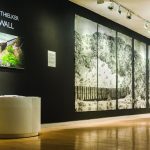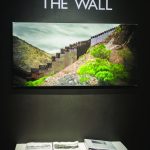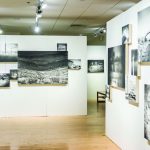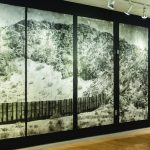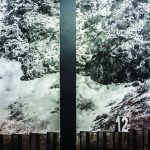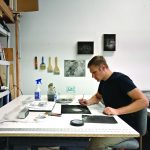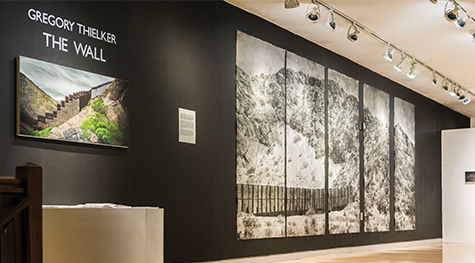
Walls are usually meant to divide, but artist Gregory Thielker is using one to unify. Thielker’s new exhibit, “The Wall,” is currently showing at Clark University’s Traina Center for the Arts until Feb. 20. In what promises to be both artistically and socially stimulating, “The Wall” is a timely and important reveal through a series of breathtaking paintings of the Mexican border.
You can’t fully grasp the situation with the border until you have personally visited it and talked with the people whose lives revolve around it, according to Thielker. Taking a break from installing the exhibit at Clark University, Thielker spoke about his own experiences traveling along the dividing line and the process he applied to capture the essence of it.
Thielker, 38, is an accomplished artist who has traveled the world painting and currently resides in New York. He describes himself as a hyper-realist painter. “A fancy way of saying I’m someone who paints representationally,” he said. “I paint what I see, and I use painting in a lot of ways as a research tool to kind of unpack and take apart what I’m looking at in the actual world.”
What Thielker saw and how he captured it for “The Wall” has to be seen to be believed. From far away, many of the paintings look like photographs. But as you take a closer look you can see the strokes of paint and how he used them to make art come to life. Images of border patrol cars, jugs of water used by undocumented people trying to cross and wide, desolate expanses at night are just some of the sights “The Wall” has to offer. Spread across canvases ranging in sizes from 9 inches by 12 inches to a gigantic 8 feet by 18 feet, the presentation of the images is intimate and grand.
“The idea of doing the border just seemed like a really amazing, man-made feature because of the way it cuts through all the different environments,” Thielker said of why he decided to pursue this project. “And I think after the election, it started to become more of an issue for public debate, and so my thought or response was ‘let me go to all these different places on the border and see really what it looks like. Talk to people there, see how they feel about it on the U.S. side and the Mexico side and really use paintings as a way of showing diversity of the landscape and perspective people have.’”
Building “The Wall” wasn’t easy, and it continues to be a work in progress for Thielker a year-and-a-half after starting it. In order to get the project to where it is today, he had to make four different trips from New York to the border. Breaking the border up into workable sections, Thielker started by flying into San Diego, traveling along the edge to Tucson and then flying back to New York, eventually flying back down south later to pick up where he left off. Thielker has already covered the entire border — almost 2,000 miles — and plans on returning to further study the landscape, he said.
When at the border, Thielker makes small studies with watercolor and also takes photographs and sketches to document what he sees. He’ll then take his findings back to his studio in New York, where he’ll spend longer stretches of time adding detail and finishing his work.
“I would spend anywhere from a few minutes to several days in each place, slowly working my way across,” said Thielker. “I wanted to see all of the landscape that I could.”
Part of his intent with “The Wall” is to try and lend a voice to those who live on the border and may not get the chance to be heard otherwise.
“I found that people were very hospitable and eager to talk about it,” Thielker said. “In an odd way, since I’ve been showing the art in New York, I’ve come across maybe some skepticism, but I never felt that when I was there. People understood why I wanted to do it, and they wanted to tell me their side of things.”
“The Wall” is now showing here in Worcester after its New York engagement. It will next be featured at Brown University. Thielker is no stranger to the Worcester area, though, having taught painting and drawing as an adjunct studio art faculty member at Clark from 2006-2009. His ties to the school are what led him to bring “The Wall” there.
Elli Crocker, professor of studio art at Clark University and director of its art gallery, couldn’t be happier to have Thielker return with his exhibit. Not only does he get to show his work, her students get a learning opportunity as well.
“For me, the fact that students can work with the artist directly installing the show, learning about his work in progress and his practice, and especially where he’s working in areas of conflict, I think all of that is very valuable to them,” she said.
For more information, visit gregorythielker.com.
Jason Savio
Photography by Demet Senturk

